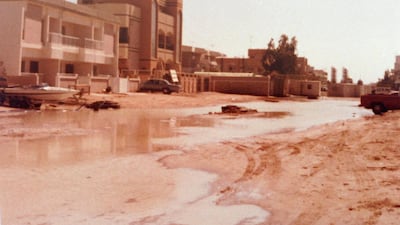At the beginning of last month, a Facebook group named Abu Dhabi Good Old Days began posting pictures from yesteryear. The group, which was established by former resident Dr Ron McCulloch, has proved a runaway hit.
In only 40 days, it has become an informal repository for the history of the city. More than 7,000 members now belong to the group and that number continues to grow.
Every day another trove of pictures makes its way online, most from the 1970s, 1980s and early 1990s. Many of these pictures document old buildings or landmarks, although some might be of people at a party, old membership cards or sports club shirts. The context of each shot is often filled in by collective effort, with many group members contributing to the discussion and providing their own details on what has just been posted.
It has been suggested that the photographs, newspaper cuttings and memorabilia collected on the page could be curated into a book, which is a great idea waiting to be picked up by an enterprising publisher − albeit one potentially laced with some knotty image-rights issues.
Of course, there is a danger in this kind of unfiltered, user-driven historical cataloguing, as it tends to preference those who shout loudest, rather than those who might have the most interesting stories to tell − a criticism made of social media − and does not present a coherent, linear narrative. But it is hard to pick away at Abu Dhabi Good Old Days on those grounds, especially when it has become a genuine and organic online success story. Long may it continue to thrive.
The story of the group has already been chronicled in this newspaper, but its existence raises a further discussion about this country's modern history and how the ever-changing nature of our communities places it under threat.
What Abu Dhabi Good Old Days reminds us of is how many perspectives need to be sought out to paint a picture rich in detail. The city looks very different literally and metaphorically from the perspective of, say, a resident of the old Tourist Club Area, now known as Al Zahiyah (even that contrast between old and new naming conventions tells a story), and someone who lives off-island in the suburbs of Khalifa City, for instance. It looks different, too, from each of the myriad international communities that thrive here.
The house I live in, which is situated on-island, was built in 1981. I know that in part because it shows the signs of decades of wear and tear, but primarily because a friend who grew up in Abu Dhabi in the 1980s remembers it being built. A while back, he presented me with a copy of a photograph he took 35 years ago, which shows the villa and the street shortly after a spring thunderstorm had swept through the city. In the foreground, enormous puddles pool on the uneven, unsurfaced roadway. In the background stands the place I have called home for several years.
I’ve long held the idea of trying to trace and tell the stories of all of the families who have lived in the villa to see what kind of history emerges. Until recently, and the introduction of the Tawtheeq tenancy contract registration system − and the establishment of groups such as Abu Dhabi Good Old Days − that would have been very hard to do. Thankfully, the increasing codification of the country should provide many unexpected breadcrumbs for the curious to pick up. In years gone by, many of them were simply swept away.
The rapid pace of change doesn’t help, either.
Each time an old building is torn down, a little more history escapes from our grasp. There are, of course, good reasons why a building may be demolished, but I have argued before, and will advocate again, for the introduction of an information plaque system to signal sites of special interest, where interesting but architecturally unimportant buildings may have once stood. Such a scheme would instantly create hundreds of opportunities for those who have come and gone to revisit the past, not to mention a wellspring of information for inquisitive tourists.
It should also be said that the National Archives, which marks its 50th anniversary this year, is active in collecting and preserving valuable historical documents. Its Watheq and My Archive My Future campaigns a couple of years ago distributed thousands of archival boxes to citizens and residents, and was designed to instil in all of us the importance of preserving records. That is a vital undertaking.
The work of the National Archives will guarantee that a great deal of the past is preserved for future historians to sift through. And on a grassroots level, groups such as Abu Dhabi Good Old Days will ensure that memories of yesteryear are kept alive, allowing us to better understand the changes the city has undergone.
It also tells us that we shouldn’t take it for granted that the details of “the way we were” will be safeguarded. Just 40 days ago, the 7,000 members of Abu Dhabi Good Old Days all had stories to tell, but no outlet for them. Those tales of the city could have been lost without trace. We should be thankful they were not. Too much of the past has gone already.


